 3-Line, Etc. Material on the iPad
3-Line, Etc. Material on the iPad
Updated 2018-08-02
Short Links:
Links ▶ Mobile Devices (tiandi.info/mobile)
Contents
- Introduction
- Seeing Pīnyīn Plus/3-line & Official English Material at the Same Time
- EPUB Files are Recommended
- Downloading and Opening EPUB Files
- Using EPUB Files in iBooks
- PDF Files and Paper Sizes
- Apps for PDF Files
- Downloading PDF Files
- Orientation and Zooming
- PDF Link Navigation and Annotation
- Sharing PDF Files
Introduction
Rather than just printing out the 3-line, etc. files on paper, people are using them more and more on computers, including mobile devices such as the iPhone, the iPod touch, and the iPad. Doing so saves time, effort, materials, and money. Also, you can do many things with digital publications like the 3-line, etc. files that you cannot do with paper printouts, like
- Have all of them with you everywhere, all the time, on your mobile device so that they’re always at your fingertips and available to be used
- Obtain them if necessary from any place where you have Internet access, any time you need them
- Very quickly find what you want in them, using bookmarks, links, searching, and other navigation aids
- Easily zoom in to get a better look at little Pīnyīn tone marks, or at critical strokes and dots in Chinese characters
- Cleanly and easily add, change, or delete annotations as needed
- Quickly and easily create copies and share them with others
- etc. ...
Because of its carefully selected sizes and relatively light weight, the iPad is particularly good for viewing and using 3-line, etc. material on. Laptop computers, as portable as they are, are often still too big and heavy to be carried around. On the other hand, while smartphone-sized devices can be used for viewing and using 3-line, etc. material, they are generally too small to be ideal for it—it has been said that an iPad is to an iPhone or iPod touch as a swimming pool is to a bathtub.
The displays on the original iPad and on the iPad 2 are quite good for displaying 3-line, etc. material, and the Retina displays on the third-generation and later iPads is very good for it—every Pīnyīn tone mark and every stroke and dot in every Chinese character is crystal clear, even at small text sizes. It has been said that looking at a Retina display is like looking at a physical page of a paper magazine.
Seeing Pīnyīn Plus/3-line & Official English Material at the Same Time
In iOS 9, which became available to the general public in the autumn of 2015, Apple introduced additional multitasking features for the iPad. Among them were Slide Over and Split Vew, which make it possible to see two apps on the display at the same time.
That makes setups like the following possible:
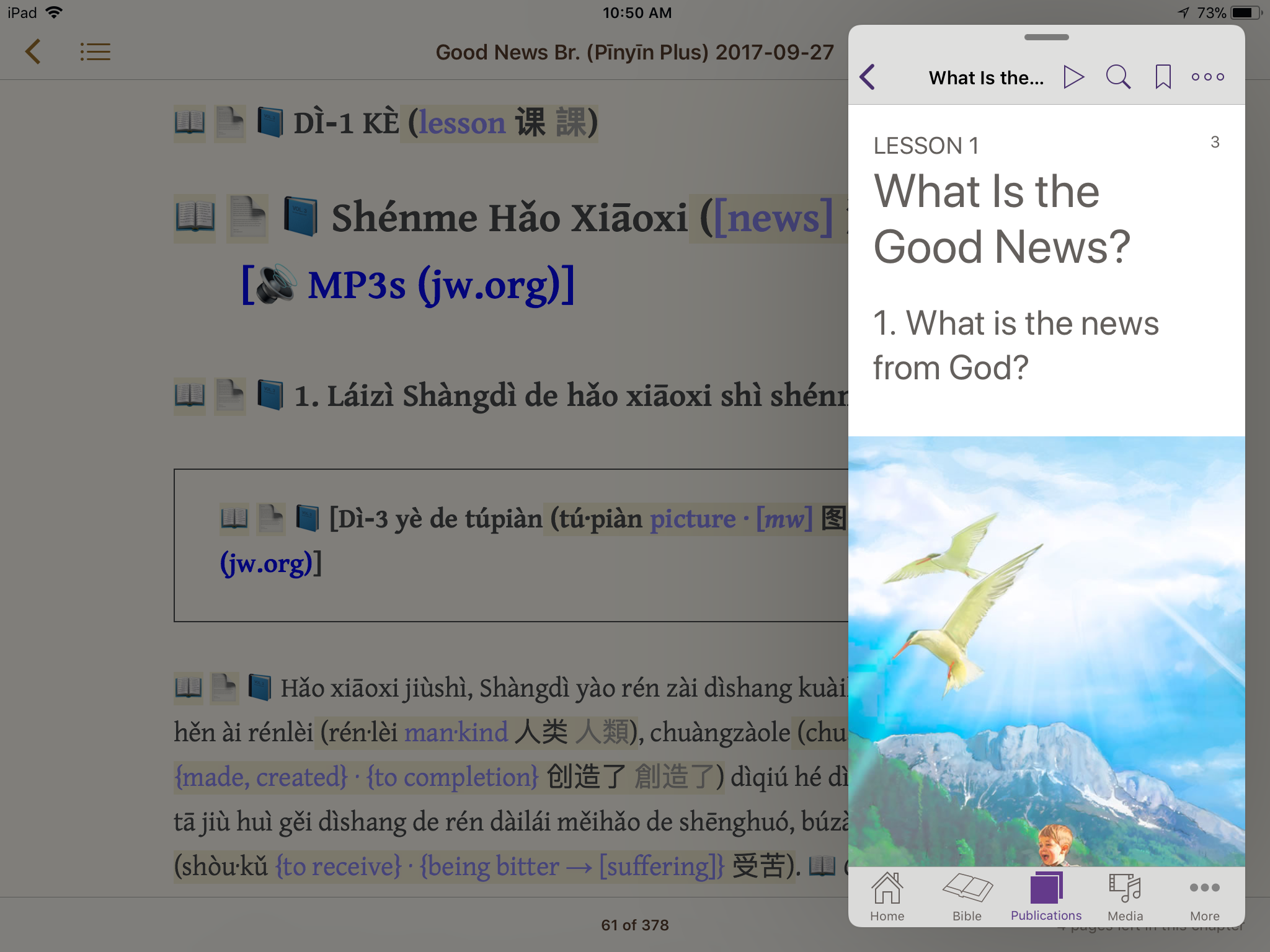
In iOS 11:
- Make sure the JW Library app has been added to your Dock.
- Open the Pīnyīn Plus Good News brochure EPUB file in iBooks.
- Swipe up from the bottom of the screen to open the Dock.
- Tap and hold on the JW Library app icon in the Dock, then drag it to the screen.
- In JW Library, go to the English Good News brochure.
- To fully go back to iBooks, just tap on it.
- To make JW Library appear again, swipe left from the right side of the screen.
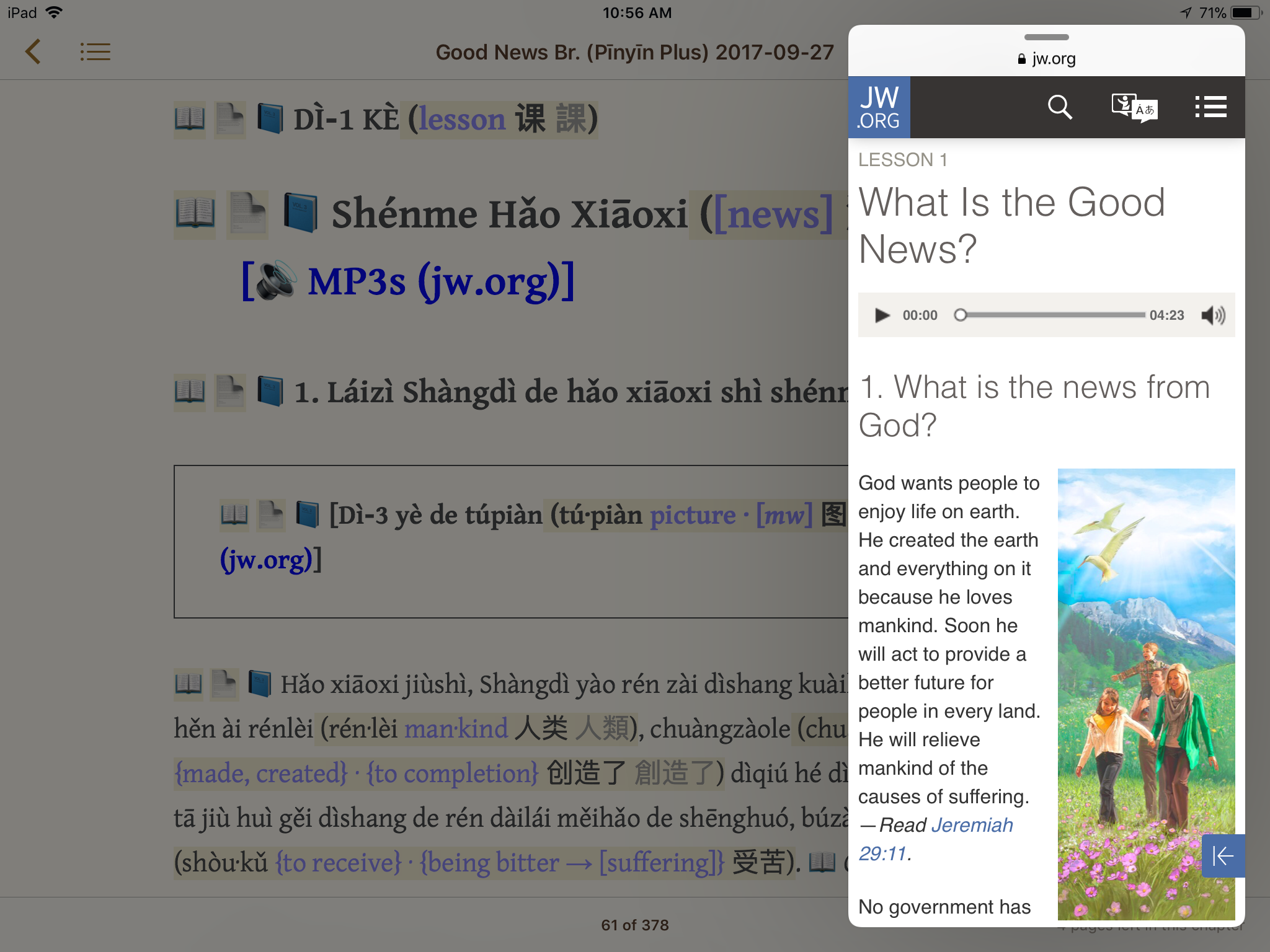
In iOS 11:
- Make sure Safari has been added to your Dock.
- Open the Pīnyīn Plus Good News brochure EPUB file in iBooks.
- Swipe up from the bottom of the screen to open the Dock.
- Tap and hold on the Safari icon in the Dock, then drag it to the screen.
- In Safari, go to the English Good News brochure on jw.org (or the WOL). (The picture links in the EPUB file can be used to quickly get the right web page loaded first.)
- To fully go back to iBooks, just tap on it.
- To make Safari appear again, swipe left from the right side of the screen.
For more information about multitasking on the iPad, see this Apple Support page:
EPUB Files are Recommended
When they are available, EPUB files are recommended for use on the iPad over PDF files. Basically, PDF files are rooted in the print world, whereas EPUB files are native to and thus more at home on computing devices like the iPad.
For example, with a PDF file, if you pinch out to enlarge the text, some text could get pushed off the right or left edges of your screen, forcing you to scroll right or left to see it. With an EPUB file, if you enlarge the text, the text will automatically reflow and adjust to the size and shape of your particular screen, and you’ll be able to go forwards or backwards in the text flow like normal without having to also scroll left and right.
Also, links in EPUB files work just like they do on web pages, so they can be used to get around in EPUB files quickly and easily, e.g. to jump to the full text of a cited scripture, and then back.
Click or tap on this link for more information on the advantages of the EPUB format:
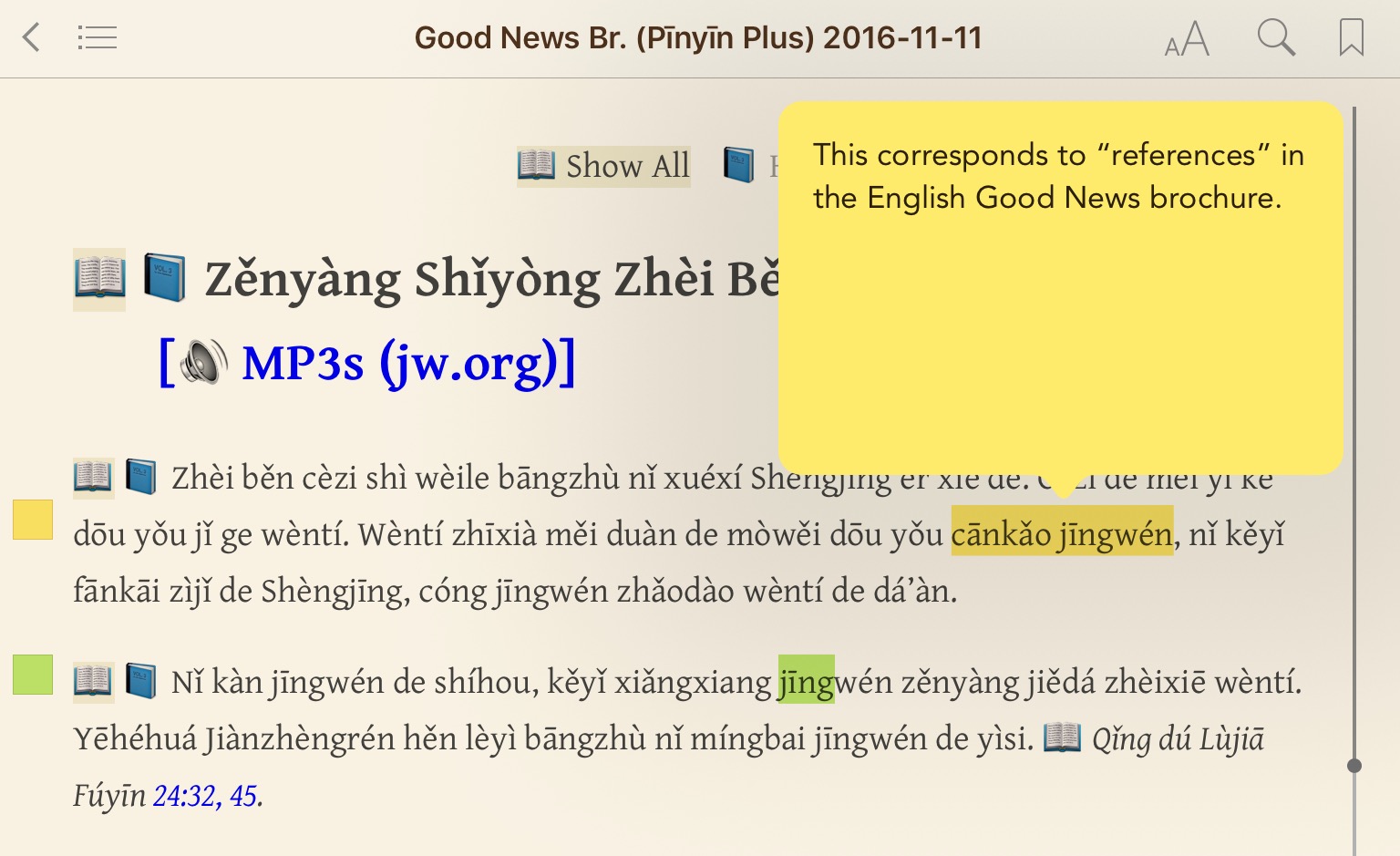
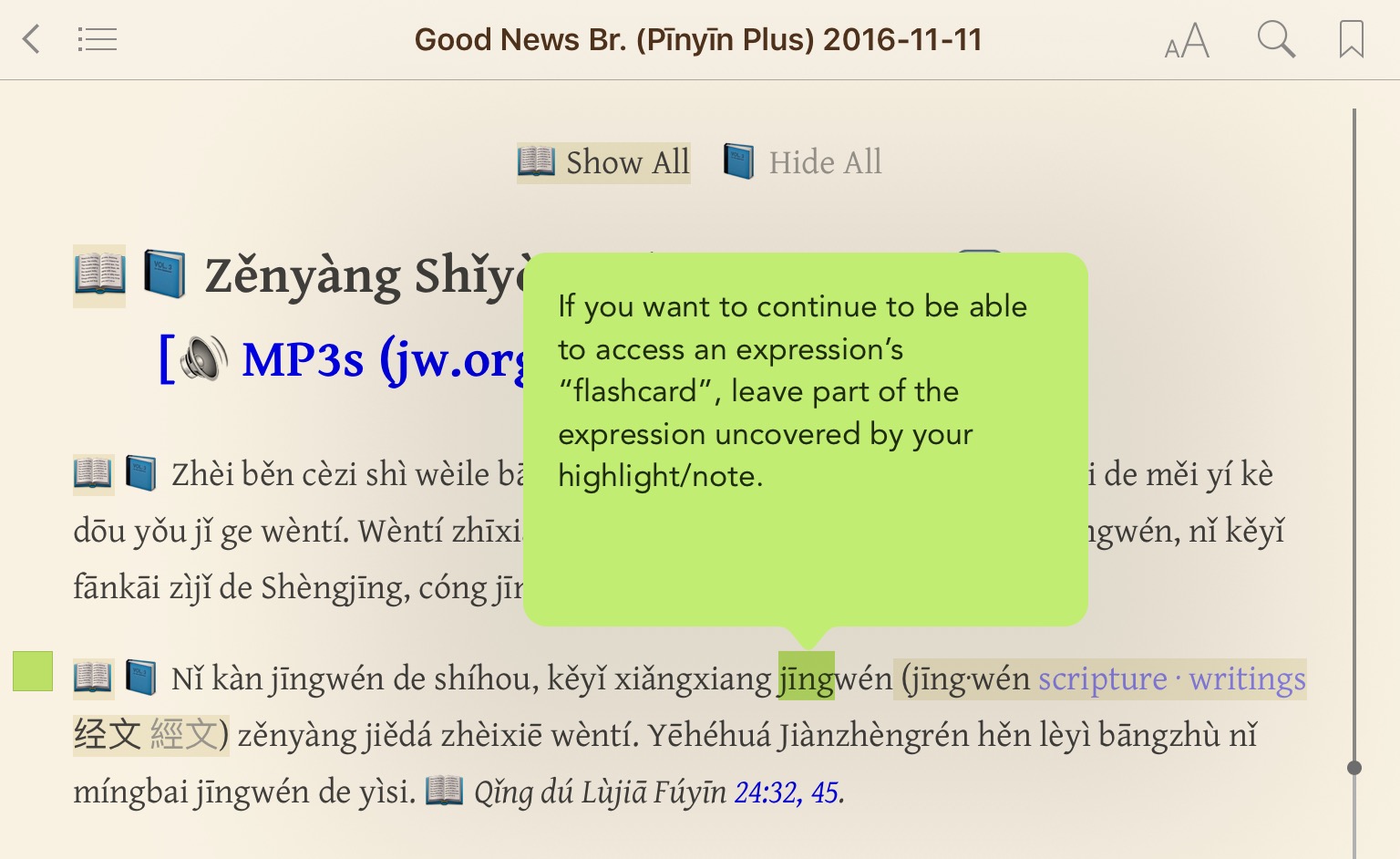
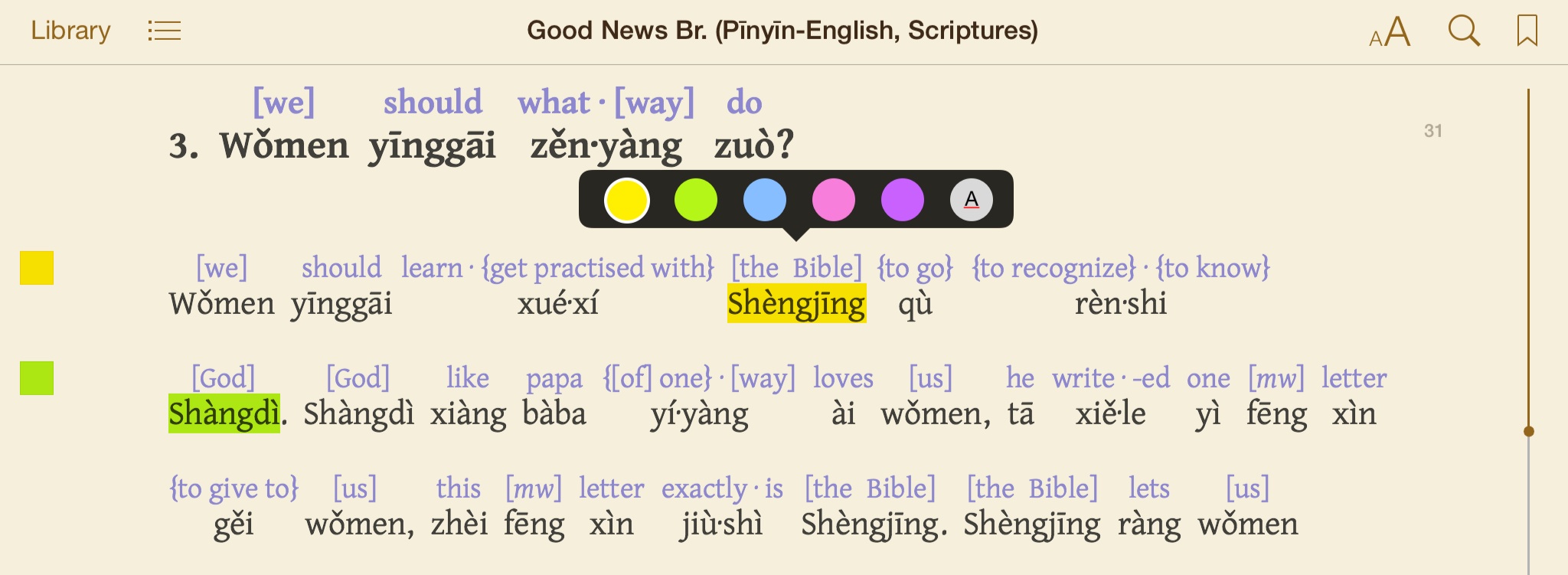
EPUB annotation in iBooks
Downloading and Opening EPUB Files
To download and open EPUB files on an iPad:
- If the iBooks app is not already installed, go here to download and install it from the App Store.
- In Safari, tap on the desired EPUB file download link.
- After the EPUB file has finished downloading, tap on the Open in “iBooks” button that appears.
Using EPUB Files in iBooks
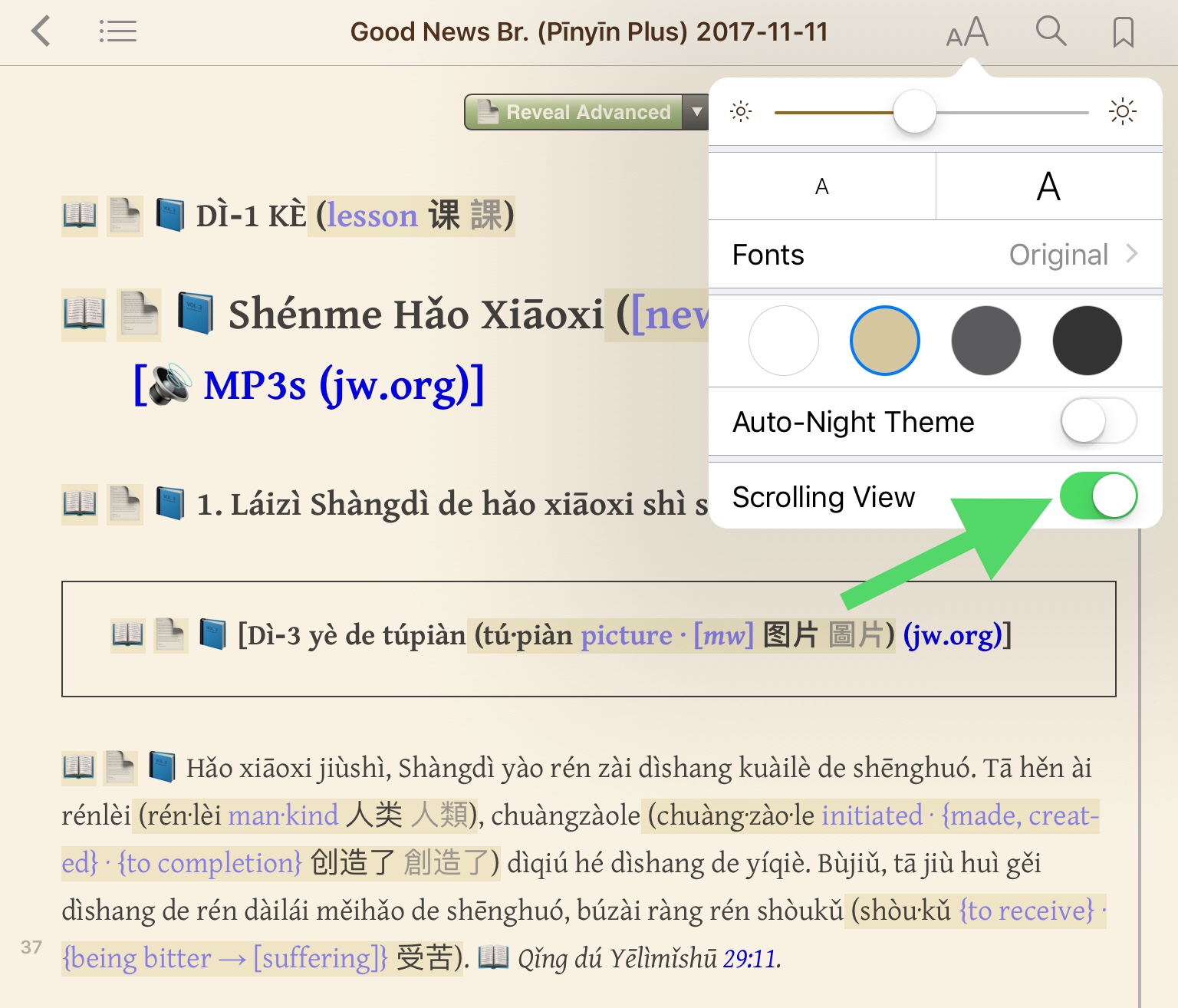
Selecting Scrolling View in iBooks
- Pīnyīn Plus EPUB files are EPUB 3 files. (This is required to enable the JavaScript-powered interactive features of the Pīnyīn Plus material.) They should work as intended in recent versions of iBooks running on Apple mobile devices with iOS 9 or newer. (They may also work in iBooks on older versions of iOS, but I have not been able to test on any versions of iOS older than iOS 9.) They should also work in recent versions of iBooks on the Mac.
- In iBooks, use the White Theme or the Sepia Theme to allow the English translations to be a different colour, and to allow the “flashcards”, the partially proofread material, and the proofread Pīnyīn material to have different background colours. (The Gray Theme and the Night Theme change all the text to be the same colour, and they set the background colour to be the same everywhere.)
- On an iPad, iPhone, or iPod touch, using Scrolling View works well, and it is a fast way of, yes, scrolling through the material. (These devices are rightly known for how quickly and smoothly they can scroll.)
- On smaller devices like the iPhone, using Scrolling View in landscape orientation is especially highly recommended.
-
Note that in iBooks on iOS, highlighting and notes get top priority for responding to touch events. So, if a highlight or note completely covers a Pīnyīn expression, then when you tap on that expression, the menu for the highlight or note will appear instead of the expression’s Pīnyīn Plus “flashcard”.
- In iBooks on iOS, if you want to add some highlighting or a note to a Pīnyīn expression, but you also want to be able to make its “flashcard” visible, then make sure the highlighting or note you add only covers part of the Pīnyīn expression, leaving enough uncovered for you to be able to tap on to show its “flashcard”.

For older Pīnyīn-English EPUB files:
- iBooks must be running on iOS 6 or newer for it to be able to properly render the wordspacing.
- Go to the Settings app, iBooks section, and turn off Full Justification.
- In iBooks, use the Sepia or White theme to let the ruby text be shown in a different colour. (The Night theme changes all the text to be the same colour.)
- Using Scrolling View is highly recommended.
For more information on setting up and using iBooks on an iPad, iPhone, or iPod touch, see Apple’s support page for that.
The rest of this page will focus on using PDF files on the iPad.
PDF Files and Paper Sizes
Both the letter/A4 paper size PDF files (such as those named with “iPad-Letter-A4”) and the PDF files named with “XLP-iPhone-A5” may be suitable for use on the iPad. XLP-iPhone-A5 files have the same content as the corresponding iPad-Letter-A4 files, but they use A5 as the paper size, resulting in the content appearing larger on-screen without requiring horizontal scrolling.
Of course, while the XLP-iPhone-A5 PDF files will be easier to read on mobile devices than the PDF files that use A4/Letter as the paper size, the latter are able to fit more information onto each page—the XLP-iPhone-A5 files just give you more options as you decide which text size/screen size/device orientation/file navigation ease combination works best for you.
Note that the XLP-iPhone-A5 PDF files may especially be more legible than the letter/A4 paper size PDF files on the iPad mini. Again, especially if you own one of these, I recommend that you try out files of both paper sizes, if available, and use what works best for you.
Apps for PDF Files
While iBooks, Adobe Reader, and many other apps may be used to load and view the 3-line, etc. PDF files on your iPad, I personally recommend using GoodReader because of its superior feature set, user experience, and performance.
Downloading PDF Files
To download a PDF file linked to on a web page on an iPad using GoodReader:
- In Safari on your iPad, tap and hold on the desired PDF file download link and tap the Copy button that appears.
- Switch to GoodReader.
- Tap on Connect.
- Tap on Enter URL. The URL (web address) you just copied from Safari should have been automatically entered into the dialogue box that appears. If not, paste it there now. Tap the OK button.
- The file should get downloaded into the My Documents > Downloads folder. If you want to move it to another folder,
- tap on Manage Files,
- tap the file to select it,
- tap the Move button,
- then navigate to your target folder and
- tap the Move 1 item here button.
- Tap the Done button to return to the normal mode.
Orientation and Zooming
PDFs are usually viewed on an iPad in portrait orientation, in which the screen is widest in the vertical dimension. However, landscape orientation, in which the screen is widest in the horizontal dimension, may also be used. To switch your iPad to landscape orientation, turn it that way while making sure that what is then the top edge is farther from the ground than the bottom edge—if the device is kept flat relative to the ground, the switch to landscape orientation will not be triggered no matter how much you turn the device.
In GoodReader, after you launch a PDF file, if you wish you may use the Crop Margins button to make the content fill out the screen more. (The Crop Margins button appears on the bottom when you tap the screen with a PDF file open.)
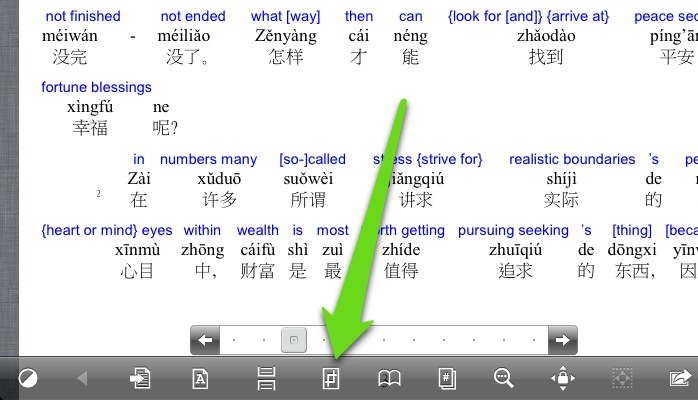
You may also zoom in by pinching your fingers apart on the screen, or by double-tapping. Proper computer text in PDF files is rendered using mathematical formulas, not bitmaps, so the text will stay sharp even if you zoom in a lot. Doing so can help you get a better look at those little Pīnyīn diacritical tone marks, or those little strokes and dots that are critical components of Chinese characters.
PDF Link Navigation and Annotation
PDF bookmarks and links work like web hyperlinks, immediately taking you to the destination linked to when they are clicked or tapped on. This capability makes PDF files much easier to navigate around in, especially on mobile devices such as the iPhone, the iPod touch, and the iPad. (See the PDF Link Navigation page for more information, including a video screen recording of the PDF bookmarks and links in action.)
GoodReader has good support for the PDF bookmarks and links used by the LinkNav and LN-A files. It even lets you add your own bookmarks. (Preexisting bookmarks may be listed in the Outlines section in the app.)
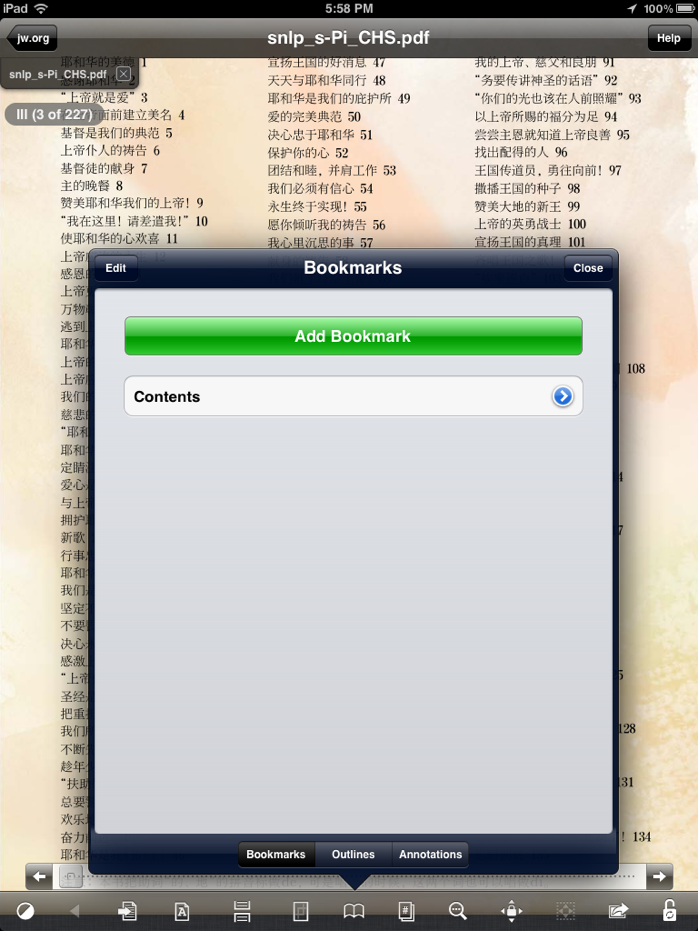
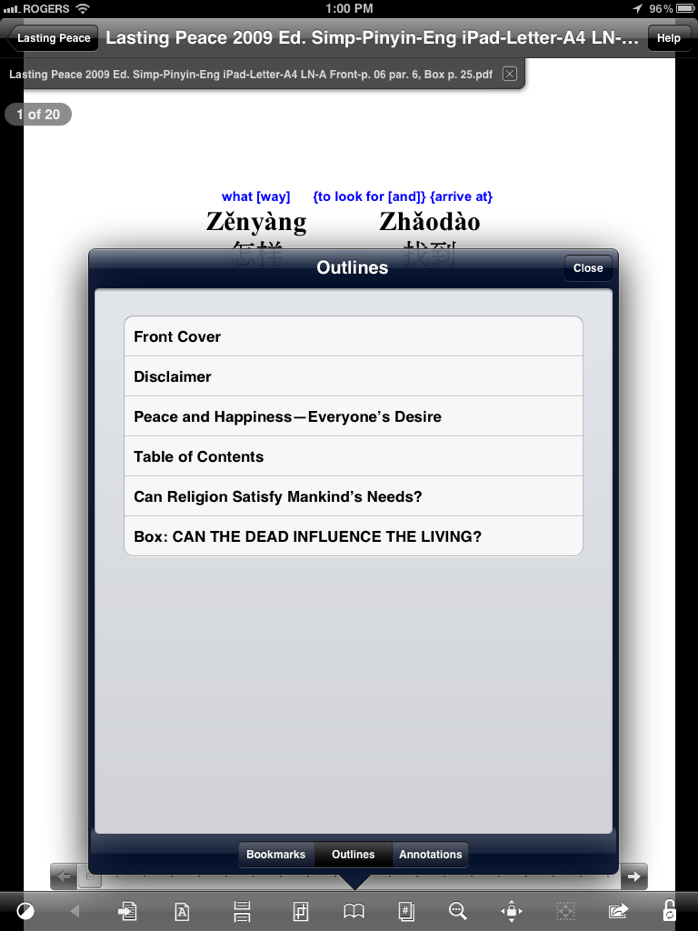
GoodReader also has good support for PDF annotation (notes & highlighting), which is enabled for desktop versions of Adobe Reader in the LN-A files. (Adobe Reader for iOS does not seem to need such special enabling.) PDF annotation is the ability to add notes or highlighting to PDFs, much like you can add margin notes, underlining, etc. to paper printouts. (See the PDF Annotation (Notes & Highlighting) page for more information.)
Sharing PDF Files
You can easily take a 3-line, etc. PDF file that’s on your iPad and share it with another person. Here are a few ways to do so:
- Direct the other person to the website from which the desired file can be downloaded.
- In GoodReader, you can open the file and email it to the other person, as shown below.
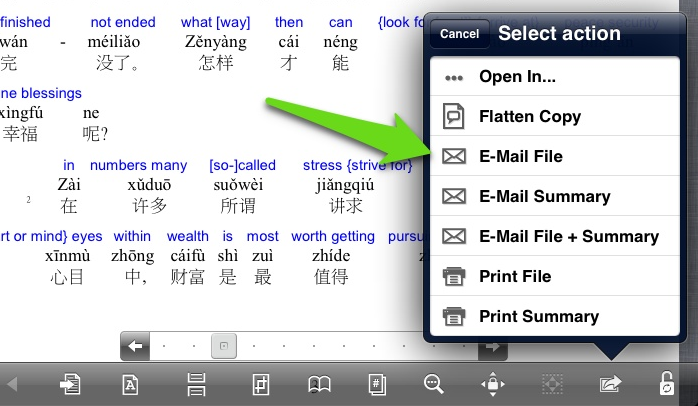
- In GoodReader running on iOS 7 or later, you can also use Apple’s AirDrop feature. To access this, just open the file and use the Open In… command shown above.
- For more information on how to set up and use AirDrop, go to this page on Apple’s website.